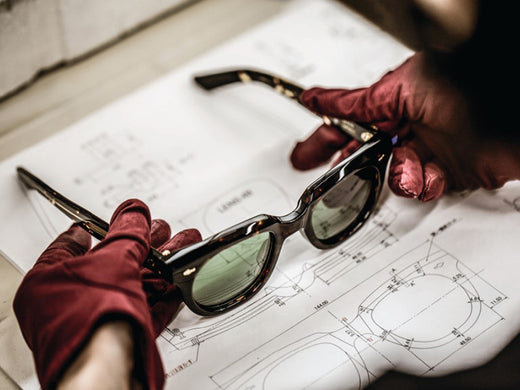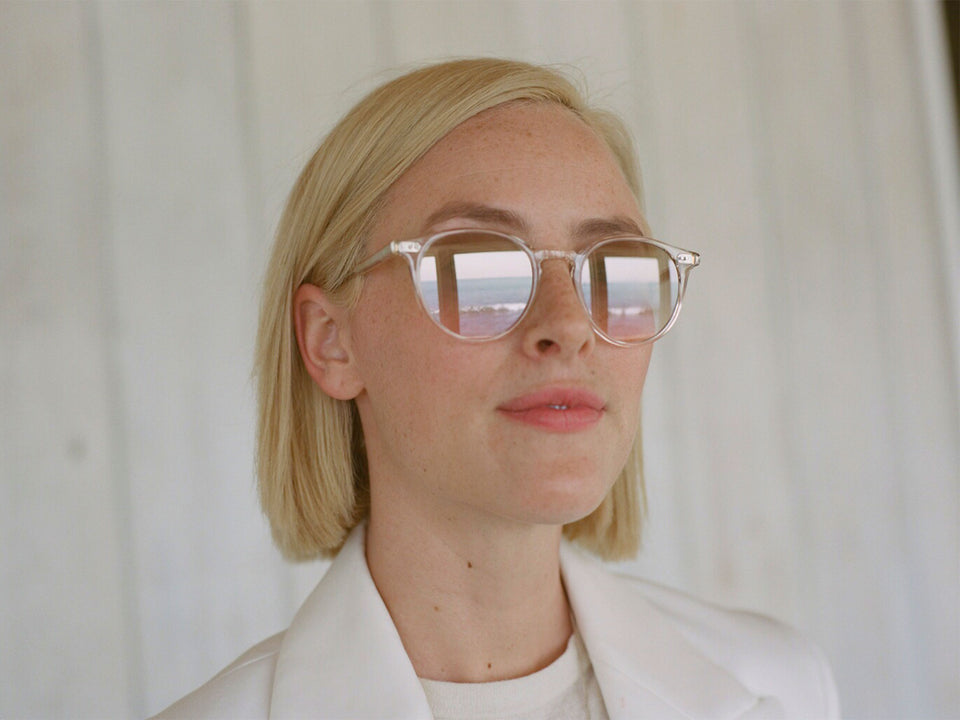On first glance, you might have Japan down as a country about forty to fifty years further into the future than the rest of the world. Tokyo is, as we’ve been led to believe, a city that’s built entirely out of giant TV screens and old parts of space ships and, if you’ve watched your fair share of Channel Five travelogues, you’ll know it’s full to the brim of cafes manned by robots and toilets that do unmentionable things with automated jets of water and perfumed steam.
“Making frames in Japan, you start to see the process to make a collection is really made by an entire village of experts.” - ED
But there is a lot more to Japanese culture than futuristic gizmos and fancy loos. Despite being so forward-looking, Japan’s also a country that’s very much proud of its history and heritage. It might be around 2000 years since the first bout, but Sumo wrestling is still the country’s national sport, after all. Even supposedly-modern Sushi dates back to the mid-19th century. At the heart of this pride in tradition is a worship of craftsmanship and the kind of highly-skilled trades that have been handed down from generation to generation. Japanese ceramics and woodwork is coveted the world over as some of the absolute best. And so, we might add, is Japanese eyewear.
When we caught up with Elena Doukas, the design director for Garrett Leight and Mr. Leight, we asked why Mr. Leight had decided to make their collection in Japan. For her, that was easy. She explained it was because “Japanese eyewear manufacturing is still very much done fully by hand”, and that it’s “usually made by several small factories instead of one larger factory.”

Mr. Leight and Garrett Leight designer, Elena Doukas
She went on to describe a production process that sounded more local handicraft than international industry-dominating. “Making frames in Japan,” she said, “you start to see the process to make a collection is really made by an entire village of experts.”
Mr. Leight isn’t the only brand that has something of a penchant for Japan-made quality, either. In fact, quite a few of our favourite brands put together their collections there; Jacques Marie Mage, True Vintage Revival, DITA, and Thom Browne have all headed over the Pacific to create frames and collections and the results are always outstanding.
So how did eyewear production find its way into Japan’s already rich cultural heritage?
A very short history of Japanese eyewear
When we talk about Japanese eyewear, we’re normally talking about eyewear made in two closely neighbouring cities, Sabae City and Fukui City which are located in the Fukui prefecture. Fukui prefecture is on the west coast of Japan’s biggest island, Honshu and lies north of Osaka and around 500km west of Tokyo. The area covers some of Japan’s most iconic scenery. There’s snow-capped mountains overlooking the cities, you can find the rugged coastline of the Sea of Japan, blossoming cherry trees lining the streets in spring, and a good covering of snow every winter. Basically, Fukui is idyllic.
At the turn of the 20th century Japan wasn’t quite as well connected by high-speed trains as it is today and, while the scenery was very much idyllic back then too, Fukui prefecture was made up of poor farming villages cut off from the rest of the country which disappeared under a thick blanket of snow for most of the winter.

In a Sabae eyewear factory, sometime in the mid-20th century
Around 1905, in one of these communities - a village called Shouno that would eventually make up part of Fukui city - a local politician called Masunaga Gozaemon wanted to help his fellow Fukui-ians and put Fukui prefecture on the map. Literature was gaining in popularity as more people throughout the world were starting to learn to read, so he figured that more people were going to need these eyeglasses things he’d been hearing about. After watching eyewear production in Tokyo and Osaka, Gozaemon decided to bring back some master craftsmen to teach his community and he set up a guild-like system that encouraged learning and specialisation.
"...The team have taken their time getting to know each company, understanding their skillsets, and selecting the best of the best for each aspect of the frame or collection."
By 1935, eyewear production wasn’t just going well in Fukui, the region had become Japan’s biggest production centre for eyewear. As technology continued to evolve, the factories of Fukui and Sabae city stayed ahead of the curve. In 1981, the region was the first place on earth to produce titanium eyewear, a material that was lightweight and durable and would come to revolutionise eyewear production.
Today, Fukui and Sabae produce 96% of Japan’s eyewear and Japan is one of the top eyewear producers in the world alongside Italy and China. The cities are home to hundreds of eyewear companies and factories but many specialise in specific, differing aspects of eyewear production and often need to work together to produce each frame. When a brand like Mr. Leight produces eyewear in Fukui, the team have taken their time getting to know each company, understanding their skillsets, and selecting the best of the best for each aspect of the frame or collection.

We couldn't find a photo Masunaga Gozaemon, but here's one of a very nice statue of him which you can find in Sabae City
Talking to us about the area’s eyewear factories, Elena Doukas said “there is the best plating acetate factory, plating factory, sample maker and tooling factory, acetate material maker, etc. It was an amazing experience to work with true experts.”
What it takes to make high-quality eyewear
Manufacturing quality eyewear isn’t quite as simple as chucking a slab of acetate into some new-fangled machine, bashing a few buttons, and standing aside to wait whilst the magic happens. It’s an intricate, tricky process that requires lots of people with lots of hard-earned skills who have all been afforded the right amount time to properly ply their craft.
Amazingly, Jacques Marie Mage say that over one hundred hands have touched each pair of their frames before they make it from Japan to their headquarters in LA, and that those hands are responsible for completing over three hundred separate tasks on each frame. Yeah, wow.

Jacques Marie Mage's possibly boobytrapped, secret stash of acetate. Somewhere in Sabae City, Japan
The earliest stages in frame production are prototyping and material selection. These require the brands to work closely with Japanese suppliers and manufactures to fine-tune the frame’s design and select from often-limited or exclusive supplies of materials like acetate. Jacques Marie Mage, for example, have a ‘private reserve room’ in Japan that contains all their custom made 10mm cellulose acetate sheets and it’s where their design vision is painstakingly brought to life. Despite making their glasses elsewhere, Garrett Leight are very proud to source a lot of their cured acetate from Japan.
Then there’s the more hands-on work. To deliver the quality that brands like Jacques Marie Mage, Thom Browne, and True Vintage Revival demand, the work really needs to be done by hand by craftspeople that know what they’re doing. Japan-made acetate frames are often cut out by hand, polished by hand, and inspected for defaults by hand. If you want to make a frame that has the look and feel of a premium frame, it sounds like handmade is a good place to start.
A culture of craftsmanship
Japan has a culture of celebrating craftsmanship that goes back aeons and remains ingrained within the country’s psyche. They know that taking pride in traditional artisanship isn’t just about looking to the past, it can be about looking forward too. That’s what really comes across when you handle and wear a pair of frames made in Japan. You can tell that care has been taken in producing them, the kind of care that you don’t see as often these days and that’s nice to have around.
We love stocking so many brands that appreciate the eyewear craftsmanship of Sabae and Fukui City in Japan. Take a closer look: shop a few of them below, book a Virtual Styling Session with us to chat about them online, or book a face to face styling consultation at our Opticians in Manchester. Until then, sayōnara!








